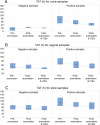Conversion of a classical microbiology laboratory to a total automation laboratory enhanced by the application of lean principles
- PMID: 38230933
- PMCID: PMC10846136
- DOI: 10.1128/spectrum.02153-23
Conversion of a classical microbiology laboratory to a total automation laboratory enhanced by the application of lean principles
Abstract
Laboratory automation in microbiology improves productivity and reduces sample turnaround times (TATs). However, its full potential can be unlocked through the optimization of workflows by adopting lean principles. This study aimed to explore the relative impact of laboratory automation and continuous improvement events (CIEs) on productivity and TATs. Laboratory automation took place in November 2020 and consisted of the introduction of WASPLab and VITEK MS systems. CIEs were run in May and September 2021. Before the conversion, the laboratory processed about ~492 samples on weekdays and had 10 full-time equivalent (FTE) staff for a productivity of 49 samples/FTE/day. In March 2021, after laboratory automation, the caseload went up to ~621 while the FTEs decreased to 8.5, accounting for productivity improvement to 73 samples/FTE/day. The hypothetical productivity went up to 110 samples/FTE/day following CIEs, meaning that the laboratory could at that point deal with a caseload increase to ~935 with unchanged FTEs. Laboratory conversion also led to an improvement in TATs for all sample types. For vaginal swabs and urine samples, median TATs decreased from 70.3 h [interquartile range (IQR): 63.5-93.1] and 73.7 h (IQR: 35.6-50.7) to 48.2 h (IQR: 44.8-67.7) and 40.0 h (IQR: 35.6-50.7), respectively. Automation alone was responsible for 37.2% and 75.8% of TAT reduction, respectively, while the remaining reduction of 62.8% and 24.2%, respectively, was achieved due to CIEs. The laboratory reached productivity and TAT goals predefined by the management after CIEs. In conclusion, automation substantially improved productivity and TATs, while the subsequent implementation of lean management further unlocked the potential of laboratory automation.IMPORTANCEIn this study, we combined total laboratory automation with lean management to show that appropriate laboratory work organization enhanced the benefit of the automation and substantially contributed to productivity improvements. Globally, the rapid availability of accurate results in the setting of a clinical microbiology laboratory is part of patient-centered approaches to treat infections and helps the implementation of antibiotic stewardship programs backed by the World Health Organization. Locally, from the point of view of laboratory management, it is important to find ways of maximizing the benefits of the use of technology, as total laboratory automation is an expensive investment.
Keywords: change management; laboratory automation; lean principles; productivity; turnaround time.
Conflict of interest statement
Yohann Bala, Monica Gutiérrez Granado, Sandra Vallejo, and Victoria Gonzalez are employees of bioMérieux SA.
Figures
References
-
- Maurer FP, Christner M, Hentschke M, Rohde H. 2017. Advances in rapid identification and susceptibility testing of bacteria in the clinical microbiology laboratory: implications for patient care and antimicrobial stewardship programs. Infect Dis Rep 9:6839. doi: 10.4081/idr.2017.6839 - DOI - PMC - PubMed
MeSH terms
LinkOut - more resources
Full Text Sources



